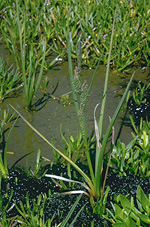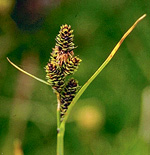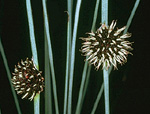 |
Members of this large, cosmopolitan family (commonly called sedges) are found throughout Australia in all habitats, from the arid interior to the high alps, and from coastal strands to rain forests. They are characteristically found in wet places, in marshes, swamps, roadside ditches or ephemeral pools, but some species have successfully adapted to drier conditions.
Characteristic features of the family Cyperaceae in Australia include: - grass-like, annual or perennial herbs, usually with pith-filled, angular or cylindrical stems and (often) three-ranked leaves with sheathing bases
- flowers small, enclosed by closely overlapping, usually brownish or greenish bracts, forming spikelets that are themselves variously aggregated into simple or compound inflorescences, usually subtended by one or more leaf-like bracts
- perianth absent or represented by scales or bristles surrounding the ovary
- stamens 3 or 6 with basifixed anthers
- ovary superior, with a single, basal ovule; fruit a dry (occasionally slightly fleshy), often three-angled nut
Description
Annual or perennial terrestrial herbs, or aquatic herbs rooted in the substrate with their leaves emergent or rarely floating, rarely herbaceous scrambling vines. Perennating by tubers or rhizomes. Vegetative reproduction absent or by tubers, rhizomes, stolons, bulbils or proliferous flowerheads. Leaves present or ±absent. Stem internodes solid, spongy or pithy or hollow, terete, oval or slightly flattened, strongly flattened or distinctly angular. Internal secretions not obvious. Plants glabrous or with simple, non-glandular, unicellular or rarely uniseriate hairs. Leaves well developed or much reduced (i.e. to scales, etc.), alternate and spiral, cauline, all or mostly basal, or both basal and cauline, sessile. Stipule-like lobes present or apparently absent. Lamina simple, symmetric, filiform, acicular, subulate or linear; margins entire, ±flat, revolute or recurved; venation parallel, with the midrib conspicuous or inconspicuous, and the tertiary venation not reticulate; surfaces not punctate; herbaceous or leathery; distinctive odour absent or rarely aromatic. Leaf ligule present or absent. Male and female flowers on the same plant or rarely on separate plants, or with all the flowers bisexual, or with bisexual flowers together with male flowers. Inflorescences terminal or axillary, consisting of capitula, glomerules, spikes, racemes, or apparently panicles or umbels, or rarely spikelets. Spathes rarely present. Bracts present. Pollination by wind, or rarely insects. Flowers odourless; sessile. Floral disc present or absent; nectaries absent. Perianth regular or irregular, of 1 whorl only or vestigial or absent, with (0–) 3–6, free, ±petaloid segments, white, cream, yellow, orange, grey, brown or black, without contrasting markings, papery. Fertile stamens 1–3 (–6), not clearly correlated with and free of the perianth segments, free of the ovary and style, distinct from each other, all ±equal. Anthers basifixed, not versatile, opening sideways or inwards by longitudinal slits; 2-celled; with appendages absent or apical or basal. Ovary superior and sessile. Carpels (1–) 2–3 (–4), fused; ovary with 1 locule. Style terminal, single and branched, rarely single and unbranched above or from the base. Ovule 1, ?sessile; placentation basal. Fruit a dry, indehiscent achene, a nut or a utricle; the perianth on the maturing fruit deciduous, rarely growing larger. Disseminule macro-surface featureless or with a pappus or rarely winged; micro-surface ±smooth, granulate, colliculate, tuberculate, papillose, verrucose, reticulate, alveolate, foveate or rugose, white, cream, yellow, orange, brown, grey or black, glossy or dull. Seeds 1 per fruit. Aril absent. Cotyledons 1. Embryo straight.
(Note: this description has been generated from the coded data compiled for the key. Any errors in the key data will be reflected in the descriptions.)
A treatment of the family Cyperaceae has not yet been published in the Flora of Australia. It will appear in Volumes 41 & 42.
Australian genera of Cyperaceae (as recognised for the Flora of Australia)
† = some species native, others introduced
* = all species introduced
Actinoscirpus
Arthrostylis
Baumea
Bolboschoenus
Bulbostylis
†Carex
Carpha
Caustis
Chorizandra
Chrysitrix
Cladium
Crosslandia
Cyathochaeta
†Cyperus
Eleocharis
Evandra
Exocarya
Fimbristylis
Fuirena
Gahnia
Gymnoschoenus
Hymenochaeta
Hypolytrum
†Isolepis
Kyllinga
Lepidosperma
Lepironia
Lipocarpha
Machaerina
Mapania
Mesomelaena
Oreobolus
Paramapania
Ptilanthelium
Pycreus
Queenslandiella
Reedia
Remirea
Rhynchospora
Schoenoplectus
Schoenus
Scirpodendron
Scirpus
Scleria
Tetraria
Thoracostachyum
Trachystylis
*Trianoptiles
Tricostularia
Uncinia

|
  |

Carex gaudichaudiana (flowering plant)
Photo: C.Totterdell © ANBG

Carex hypandra (fruits)
Photo: C.Totterdell © ANBG

Carpha nivicola (flowering plant)
Photo: C.Totterdell © ANBG

Chorizandra enodis (flowers)
Photo: M.Fagg © ANBG

|

| |